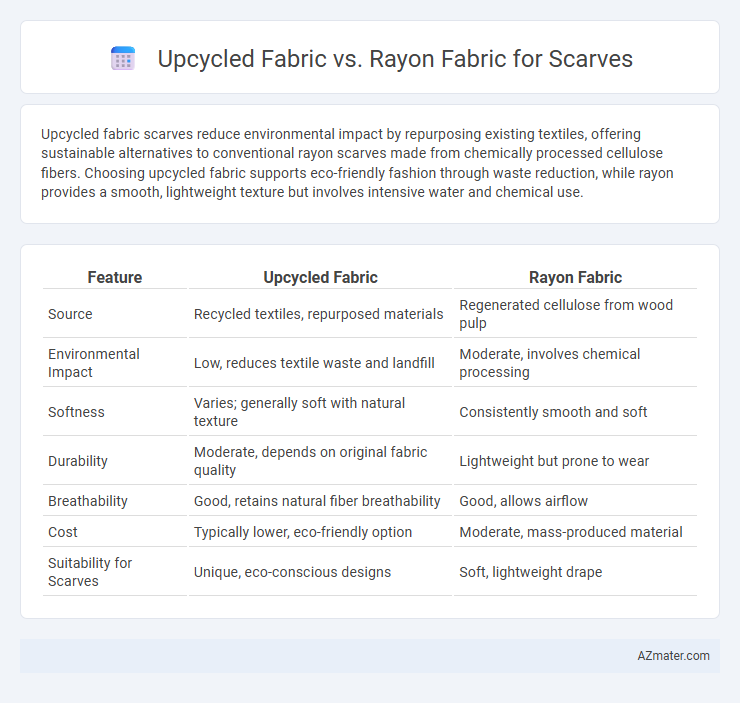Upcycled fabric scarves reduce environmental impact by repurposing existing textiles, offering sustainable alternatives to conventional rayon scarves made from chemically processed cellulose fibers. Choosing upcycled fabric supports eco-friendly fashion through waste reduction, while rayon provides a smooth, lightweight texture but involves intensive water and chemical use.
Table of Comparison
| Feature | Upcycled Fabric | Rayon Fabric |
|---|---|---|
| Source | Recycled textiles, repurposed materials | Regenerated cellulose from wood pulp |
| Environmental Impact | Low, reduces textile waste and landfill | Moderate, involves chemical processing |
| Softness | Varies; generally soft with natural texture | Consistently smooth and soft |
| Durability | Moderate, depends on original fabric quality | Lightweight but prone to wear |
| Breathability | Good, retains natural fiber breathability | Good, allows airflow |
| Cost | Typically lower, eco-friendly option | Moderate, mass-produced material |
| Suitability for Scarves | Unique, eco-conscious designs | Soft, lightweight drape |
Introduction: Understanding Upcycled and Rayon Fabrics
Upcycled fabric for scarves is created by repurposing textile waste, reducing environmental impact through sustainable production. Rayon fabric, derived from regenerated cellulose fibers, offers a smooth texture and vibrant drape but involves chemical processing that can affect ecological balance. Comparing upcycled and rayon fabrics highlights the trade-offs between eco-friendly practices and fabric performance in scarf manufacturing.
Environmental Impact: Upcycled vs Rayon Fabric
Upcycled fabric for scarves significantly reduces environmental impact by reusing existing materials, minimizing waste, and conserving resources compared to rayon fabric, which requires extensive chemical processing and large water consumption during production. Rayon manufacturing involves hazardous chemicals such as carbon disulfide, contributing to pollution and ecological harm, whereas upcycled fabrics promote sustainability by extending textile life cycles. Choosing upcycled fabric supports eco-friendly fashion practices by lowering carbon footprints and reducing landfill contributions relative to conventional rayon materials.
Production Process: How Each Fabric Is Made
Upcycled fabric for scarves is created by repurposing pre-existing textile materials, reducing waste through a sustainable, eco-friendly production process that emphasizes recycling and minimal environmental impact. Rayon fabric is manufactured from regenerated cellulose fibers derived from wood pulp, undergoing chemical treatment and spinning processes that transform natural fibers into a smooth, soft textile. The production of upcycled fabric prioritizes resource conservation and waste reduction, whereas rayon involves extensive chemical processing to achieve its desired texture and appearance.
Softness and Comfort: Comparing Feel and Wearability
Upcycled fabric scarves offer unique softness derived from reclaimed fibers, often providing a breathable and lightweight texture ideal for sensitive skin. Rayon fabric, made from regenerated cellulose fibers, is renowned for its silky smoothness, draping elegantly while maintaining a cool, comfortable wear throughout the day. Both materials excel in softness, but rayon typically delivers superior smoothness and consistent wearability compared to the variable texture of upcycled fabrics.
Durability and Longevity of Upcycled and Rayon Scarves
Upcycled fabric scarves often exhibit enhanced durability due to their sturdy, previously tested fibers, which contribute to a longer lifespan compared to rayon scarves. Rayon, while soft and lightweight, tends to weaken with frequent washing and exposure to moisture, reducing its overall longevity. Choosing upcycled fabric scarves ensures a sustainable, robust accessory that withstands everyday wear better than rayon alternatives.
Style and Versatility: Fashion Possibilities
Upcycled fabric scarves offer unique, eco-friendly styles with one-of-a-kind patterns and textures that elevate any outfit, making them perfect for sustainable fashion enthusiasts. Rayon fabric scarves provide a smooth, silky drape with vibrant colors and a lustrous finish, ideal for both casual and formal wear. Both materials deliver versatile accessory options, but upcycled fabric stands out for its distinctiveness and environmental impact, while rayon excels in softness and fluidity.
Skin Sensitivity and Allergies: Safety Considerations
Upcycled fabric scarves often contain natural fibers that reduce the risk of skin irritation and allergies, making them suitable for sensitive skin. Rayon fabric, derived from cellulose but chemically processed, can sometimes cause allergic reactions or skin sensitivity due to residual chemicals or additives. Choosing upcycled fabric for scarves provides a safer, more hypoallergenic option for individuals prone to skin sensitivities and allergies.
Cost Comparison: Price and Value
Upcycled fabric scarves typically cost less than rayon fabric scarves due to the use of recycled materials, reducing raw material expenses and environmental impact. Rayon fabric, being a semi-synthetic fiber derived from cellulose, generally carries higher production costs but offers a smoother texture and vibrant dye absorption, providing increased aesthetic value. Consumers seeking eco-friendly and budget-conscious options often prefer upcycled fabric, while those prioritizing softness and luxurious feel may invest more in rayon scarves.
Ethical and Social Implications
Upcycled fabric for scarves significantly reduces textile waste by repurposing discarded materials, promoting sustainability and lowering environmental impact compared to rayon fabric, which often relies on chemically-intensive production from wood pulp. The use of upcycled fabric supports ethical fashion initiatives by empowering artisans and communities through fair labor practices, while rayon manufacturing can contribute to deforestation and exploitative labor conditions in certain regions. Choosing upcycled textiles aligns with social responsibility goals by fostering circular economy principles and minimizing the carbon footprint associated with scarf production.
Final Verdict: Choosing the Right Fabric for Your Scarf
Upcycled fabric offers eco-friendly benefits with unique patterns and durability, making it ideal for sustainable fashion enthusiasts seeking an ethical choice. Rayon fabric provides a soft, smooth texture and vibrant drape, perfect for those prioritizing comfort and elegant aesthetics. Choosing the right fabric depends on your values: sustainability and individuality point towards upcycled fabric, while luxury and softness favor rayon for your scarf.

Infographic: Upcycled fabric vs Rayon fabric for Scarf
 azmater.com
azmater.com